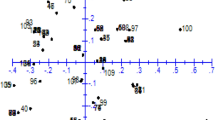Abstract
The use of AFLP analysis to produce DNA profiles from a set of 55 wheat varieties, commonly grown in the UK over the past 60 years, is described. Using six different primer pairs, 90 polymorphic bands were readily recognised and recorded. These AFLP bands are not significantly clustered and hence can be used with some confidence, even though they are not mapped. Statistical approaches to the analysis of the data were developed such that the discrimination between the varieties achieved by the use of the six primer pairs, both separately and in combination, could be derived and compared to that achieved by a common set of morphological descriptors. Various criteria for the definition of distinctness in terms of the number of band differences required between pairs of varieties were also compared. In general, higher levels of discrimination were achieved by the inclusion of greater numbers of bands in the analysis. The optimal number of polymorphic bands appears to be between v and 2v, where v is the number of varieties under test. Discrimination levels were adversely affected if the number of bands was below v/2. Distinctness levels achieved by the use of molecular markers can be calibrated so that they reproduce those seen with morphological characters. The results are discussed in relation to the possible use of DNA profiling methods for distinctness, uniformity and stability testing.
Similar content being viewed by others
References
Cooke, R.J., 1995. Varietal identification of crop plants. In: J. Skerritt & R. Appels (Eds), New Diagnostics in Crop Sciences, pp. 33-63. CAB International, Wallingford.
Cooke, R.J. & J.C. Reeves, 1998. Cultivar identification-a review of new methods. In: A.F. Kelly & R.A.T. George (Eds), Encyclopedia of Seed Production of World Crops, John Wiley & Sons, London (in press).
Devos, K.M. & M.D. Gale, 1992. The use of random amplified polymorphic DNA markers in wheat. Theor Appl Genet 84: 567-570.
Donini, P., J.R. Law, P. Stephenson, & R.M.D. Koebner, 1997a. Analysis of genetic diversity in past and present varieties of Triticum aestivumusing AFLP and microsatellites. Proceedings of Plant & Animal Genome V, San Diego 1997.
Donini, P., L. Elias, S. Bougourd & R.M.D. Koebner, 1997b. AFLP fingerprinting reveals pattern differences between template DNA extracted from different plant organs. Genome 40: 521-526.
Flavell, R.B., J. Rimpau & D.B. Smith, 1977. Repeated DNA relationships in four cereal genomes. Chromosoma 63: 205-222.
Gale, M.D., S. Chao & P.J. Sharp, 1990. RFLP mapping in wheat-progress and problems. Proceedings 19th Stadler Genetics Symposium, pp. 353-363, Plenum Press, New York.
Gower, J.C., 1966. Some distance properties of latent root and vector methods used in multivariate analysis. Biometrika 55: 582-585.
Hayes, P.M., J. Cerono, H. Witsenboer, M. Kuiper, M. Zabeau, K. Sato, A. Kleinhofs, D. Kudrna, A. Kilian, M. Saghai-Maroof & D. Hoffman and the North American Barley Genome Mapping Project, 1997. Characterizing and exploiting genetic diversity and quantitative traits in barley (Hordeum vulgare) using AFLP markers. J. Quant. Trait Loci 3, Article 2:http://probe.nalusda.gov:8000/otherdocs/jqtl.
Lee, D., J.C. Reeves & R.J. Cooke, 1996a. DNA profiling and plant variety registration: 1. The use of random amplified DNA polymorphisms to discriminate between varieties of oilseed rape. Electrophoresis 17: 261-265.
Lee, D., J.C. Reeves & R.J. Cooke, 1996b. DNA profiling and plant variety registration: 2. Restriction fragment length polymorphisms in varieties of oilseed rape. Plant Varieties & Seeds 9: 181-190.
Lee, D., J.C. Reeves & R.J. Cooke, 1996c. DNA profiling for varietal identification in crop plants. Proceedings BCPC Symposium No. 65: Diagnostics in Crop Production. pp. 235-240.
Moore G, S. Abbo, W. Cheung, T. Foote, M.D. Gale, R.M.D. Koebner, A. Leitch, I. Leitch, T. Money, P. Stancombe, M. Yano M & R.B. Flavell, 1993. Key features of cereal genome organization as revealed by the use of cytosine methylation-sensitive restriction endonucleases. Genomics: 15: 472-482.
Morell, M.K., R. Peakall, R. Appels, L.R. Preston, & H.L. Lloyd, 1995. DNA profiling techniques for plant variety identification. Aust J Exp Agric 35: 801-819.
Penner, G.A., A. Bush, R. Wise, W. Kim, L. Dornier, K. Kasha, A. Laroche, G. Scoles, S.J. Molnar & G. Fedak, 1993. Reproducibility of random amplified polymorphic DNA (RAPD) analysis among laboratories. PCR Methods & Applications 2: 341-345.
Powell W, W.T.B. Thomas, E. Baird, P. Lawrence, A. Booth, B. Harrower, J.W. McNicol & R. Waugh, 1997. Analysis of quantitative traits in barley by the use of amplified fragment length polymorphism. Heredity: 78: 48-59.
Smith, J.S.C., 1995. Identification of cultivated varieties by nucleotide analysis. In: C.W. Wrigley (Ed), Identification of Food Grain Varieties, pp. 131-150, AACC, USA.
Sneath, P.H.A. & Sokal, R.R., 1973. Numerical taxonomy. W.H. Freeman & Co., San Francisco. UPOV, 1994. Guidelines for the Conduct of Tests for Distinctness, Uniformity and Stability: Wheat. Paper TG/3/11, UPOV, Geneva.
Vos P., R. Hogers, M. Bleeker, M. Reijans, T. van de Lee, M. Hornes, A. Freijters, J. Pot, J. Peleman, M. Kuiper & M. Zabeau, 1995. AFLP: a new technique for DNA fingerprinting. Nucl Acid Res: 23: 4407-4414.
Weatherup, S.T.C., 1974. A computer program, DUST, for the analysis of distinctness, uniformity and stability trials. J Nat Inst Agric Bot: 13, 244-251.
Zabeau M.& P. Vos, 1993. Selective restriction fragment amplification: a general method for DNA fingerprinting. European Patent Application number: 92402629.7, Publication number 0 534 858 A1.
Author information
Authors and Affiliations
Rights and permissions
About this article
Cite this article
Law, J.R., Donini, P., Koebner, R.M. et al. DNA profiling and plant variety registration. III: The statistical assessment of distinctness in wheat using amplified fragment length polymorphisms. Euphytica 102, 335–342 (1998). https://doi.org/10.1023/A:1018318701458
Issue Date:
DOI: https://doi.org/10.1023/A:1018318701458




